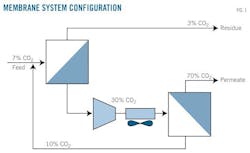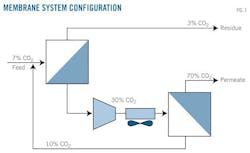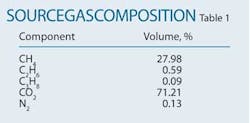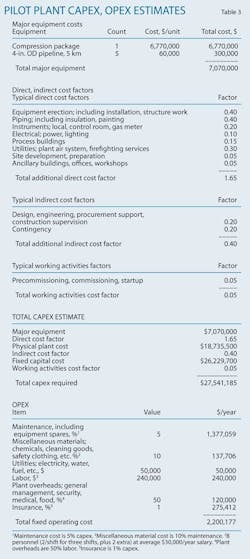Mahmoud Abu El Ela
Cairo University
Egypt
Enhanced oil recovery via miscible flooding with CO2 is an increasingly viable substitute globally for water flooding, but each case requires careful project design and cost estimation of the CO2 transport system supplying the field. This article uses Egypt's Tut field as an example of how to determine the weight of particular design and cost variables.
Background
Production from enhanced oil recovery (EOR) projects supplies a growing percentage of the world's oil. About 3% of worldwide production now comes from EOR.1 2 Worldwide, the volume of oil produced by EOR doubled to 1.2-million b/d between 1982 and 1990 and doubled again to 2.5-million b/d in 2006 (OGJ, Apr. 17, 2006, p. 46). In 2012, the volume of oil produced by EOR was about 1.7-million b/d (OGJ, Apr. 2, 2012, p. 57).
Miscible flooding with CO2 is the most widely used EOR recovery process. The availability of CO2 will likely increase the number of CO2 flood projects.3 The main barrier to further implementing the technique is the economics of CO2 supply. CO2 miscible flooding is currently implemented only where CO2 is available in large quantities and at low cost.
CO2 projects can be deployed towards the conventional end of life of a reservoir, a few years before, and even as late as roughly when secondary oil recovery stops since no configuration changes in the well pattern are required.
Miscible projects can use the same wells as waterflooding. Projects can also be implemented to individual parts of the reservoir on a smaller scale. Incremental oil production occurs relatively quickly, typically within 1-5 years from project-start depending on reservoir characteristics and spacing between the injection and producing wells.4 A miscible displacement operation can use the same equipment as waterflooding.
Additional infrastructure needed for a miscible displacement project in an existing oil recovery operation includes:
• Reception, conditioning facilities for the CO2 (including addition of corrosion inhibitors).
• CO2 compression, recycling lines.
• Monitoring equipment.
CO2 has long been shipped over large distances by pipeline. West Texas has 3,900 km of integrated CO2 pipeline that delivered more than 25-million tonnes in 2003. Strict water control limits in the CO2 (<0.5 g/normal cu m) have managed internal pipe corrosion of the carbon steel pipelines.4
Corrosion of iron infrastructure, however, remains a major issue in handling CO2. CO2–induced corrosion occurring at the injection well as CO2 dissolves in water to produce carbonic acid has to be managed. Carbonic acid is corrosive to carbon steels, making the bottom of the injector wells, and the casing and tubing that make up the annular producer wells, potentially liable to corrosion.5
A polyethylene lining in the affected tubing manages CO2 corrosion in West Texas. The annulus between the casing and tubing is also filled with an inhibitor fluid, typically reducing corrosion's effects to < 2.5 µm/year.4 Stainless steel manifolds also collect the produced oil-CO2-water mixture.
This article assesses design requirements and cost estimates for implementing a CO2 injection project in Tut field.
Tut project
The Tut field is suitable for application of CO2 EOR technology. In the southeast part of the Khalda concession in the north part of Egypt's western desert, Tut currently uses a waterflood mechanism. It was discovered in 1986 and has 50 oil producing wells and 11 water injection wells.
Tut produced conventionally until November 2006, when waterflooding was introduced. Volumetric estimates showed the field had 13.6-million stb of original oil in place. The operator expects waterflooding of AEB-3D to increase recovery to 35%, resulting in an ultimate oil recovery of 4.8-million bbl at the end of the secondary recovery process.
Cumulative production from the zone totals 4.5-million bbl. Estimated reservoir pressure is 2,600 psig compared with 3,500 psig initially. AEB-3D is producing 400 bo/d from five wells, with several other wells shut in due to normal depletion (OGJ, Jan. 7, 2008, p. 43).
Screening analysis demonstrated that CO2 injection had the most potential for a future miscible-flood project of the AEB-3D formation. Results showed CO2 injection will yield an incremental cumulative production of about 1.44-million stb (OGJ, Jan. 7, 2013, p. 74) and an incremental recovery factor of 10.8%. CO2 is also an attractive injection option for Tut field because of its availability. Khalda Petroleum Co.'s Salam gas plant in Egypt's Western Desert is about 5 km from Tut and produces CO2 as a by-product.
Selecting the most suitable EOR method requires considering the required surface facilities, equipment, and piping. This article will examine the surface facility requirements for a CO2 pilot project injecting 5 MMscfd CO2, based on expected incremental oil recovery of 500 b/d using a utilization factor of 10,000 scf CO2/incremental barrel of oil recovered.6 7
Gas source
The Salam gas plant processes gas condensate from Salam field, Qasr field, South Umbarka, and a nearby oil plant's associated gas, producing about 400 MMscfd of export gas and 40,000 b/d of condensate. It includes a membrane sweetening system to separate CO2 from the treated gas.
The membrane system which started at the Salam gas plant in July 1999 includes two stages. The first membrane stage produces a residual gas (sales gas) with 3% mol CO2, supplied to the export compressors for gas metering (Fig. 1). Permeate gas containing 30% mol CO2 runs through the permeate compressor and then to the second stage membrane package.
The second membrane stage recovers most of the hydrocarbons from the first-stage permeate gas. Second membrane stage residual gas recycles back to the first membrane stage. Second-stage permeate gas containing 71% mol CO2 is flared. Part of this permeate stream can be used in the proposed CO2 injection pilot project.
Conceptual design and economic evaluation of the pilot project to move 5 MMscfd of the CO2-rich gas from Salam plant to the Tut field depend on parameters such as the following:
• Compression requirement at Salam gas plant.
• Design of the CO2 gas pipeline from Salam plant into the injector at Tut field.
• Corrosion and metallurgy of the new compression and pipeline.
• Expected operating (opex) and capital (capex) costs of the pilot project.
Design
A short-term study yielded the following parameters to consider while designing compression and the proposed pipeline:
• Design flow rate = 5 MMscfd.
• Source gas is CO2 rich gas (Table 1).
• Design pressure and temperature of the CO2-rich gas downstream from the membrane system of Salam gas plant is 20 psi and 50° C.
• Pipeline is buried to 100-cm depth to top of pipe.
• Soil temperatures at buried depth are 7° C. in winter and 30° C. in summer.
• Pipe route is assumed to be flat with constant elevation.
• Gas water content is limited to a trace.
• Design pressure at the injector = 2,600 psi.
• Hydraulic calculations are based on a 5-km pipeline length.
Fig. 2 shows a snap shot of the HYSYS software simulation model for the proposed compression and pipeline. The main facilities include a five-stage compression station designed to compress gas starting at 20 psi to 2,616 psi. Each compression stage includes knockout drum, compressor, and air cooler. The pipeline will then transfer the CO2-rich gas from the Salam gas plant into the injector at Tut field.
The compression ratio of each stage is designed to be < 3.78 and the temperature downstream of each compression stage < 150° C. The air cooler downstream of each compression stage is designed to reduce gas temperature to 60° C. before entering the following compression stage.
Table 2 shows the main design parameters of the compression station, with ratios of about 3.55, 2.68, 2.51, 2.40, and 2.38 in the five stages, respectively. The final temperature downstream of each compression stage is accepted in terms of compressor mechanical seal. Front-end engineering and design (FEED) and detailed engineering should endorse these criteria, with the compressor vendor defining final package configuration.
Hydraulic calculations indicated that a 4-in. OD pipeline is required to transfer the CO2-rich gas from the Salam gas plant into the injector at Tut field. Corrosion inhibitors should be injected into the pipeline. The doses and the type of the corrosion inhibitors should be identified by a chemical treatment company during the FEED phase. Internal coating should also be considered in the design.
Decision-support package
This article presents a decision-support package (DSP) which includes cost estimates and a project execution schedule. Budget and schedule are main drivers because they govern the commercial viability of the project. Table 3 presents the project's estimated capital (capex) and operating (opex) expenses. The estimated purchase costs of major equipment items, as collected from recent projects, provide the basis for the capex estimate. Other costs (direct and indirect costs) are estimated as factors of the equipment cost8 based on previous experiences and recent projects.
Main direct-cost items include:8
• Equipment erection; including foundations and minor structural work.
• Piping, including insulation and painting.
• Electrical power, lighting.
• Instruments; local and control room.
• Process buildings, structures.
• Ancillary buildings, offices, workshops.
• Utilities, services: provision of plants for water, air, firefighting.
• Site preparation.
Main indirect-cost items include:8
• Design and engineering costs; including purchasing, procurement, and construction supervision.
• Contingency allowance; built into capital cost estimate to cover for unforeseen circumstances (labor disputes, design errors, adverse weather).
Working activities costs include precommissioning, commissioning, and start-up activities.8
Total capex estimate uses the purchase cost of the major equipment along with the direct, indirect, and working activities cost factors (Table 3). The total physical plant cost = cost of the major equipment × (1+ main factor of direct cost)
Table 3 also shows how to estimate the main factor of indirect cost and the factor of working activities. The fixed capital cost is the total cost of the plant ready for start-up. Fixed capital costs = total physical plant cost × (1+ main factor of indirect cost). Total capex = fixed capital costs × (1+ factor of working activities).
The accuracy of this type of estimate is ± 35-40%. A more accurate estimation of project capital costs can be made in the later stages of project design (FEED and detailed engineering), when detailed equipment specifications are available and firm quotations have been obtained.
Judging the viability of a project also requires an opex estimate. Opex includes all expenditures essential to run the operation properly, mainly the following items shown in Table 3:8
• Maintenance costs, including equipment spares.
• Miscellaneous material cost, including chemicals, cleaning material, safety clothing.
• Utilities, services costs: electricity, water, fuel.
• Labor costs.
• Plant overheads, including general management, plant security, medical, food.
• Insurance costs.
Table 3 shows the annual estimated contribution of each of these items and estimates capex and opex of the pilot project at $27.5 million and $2.2 million, respectively, which can be earned in 2 years of pilot production.
Project delivery encompasses total project duration, from engineering and design to commissioning and startup. The total project duration is estimated at 12-16 months:
• 4 months for engineering and design.
• 6-8 months for procurement.
• 4-6 months for construction, pre-commissioning, commissioning, and startup.
• 2 months overlap can be factored in during the procurement and construction stages.
Acknowledgement
The author thanks Khalda Petroleum Co. for permission to publish this article.
References
1. Taber, J.J., Martin, F.D., and Seright, R.S., "EOR Screening Criteria Revisited - Part 1: Introduction to Screening Criteria and Enhanced Recovery Field Projects," Paper No. SPE 35385-PA, SPE Reservoir Engineering Journal, August 1997, Vol. 12, No. 3, p. 189.
2. Sayyouh, M.H., and Al-Blehed, M., "Screening Criteria for Enhanced Recovery of Saudi Crude Oils," Energy Sources, 1990, Vol. 12, No. 1, p. 71.
3. Alvarado, V., and Manrique, E., "Enhanced Oil Recovery: An Update Review," Energies, Aug. 27, 2010, Vol. 3, No. 9, p. 1,529.
4. Tzimas, E., Georgakaki, A., Garcia Cortes, C., and Peteves, S.D. "Enhanced Oil Recovery using Carbon Dioxide in the European Energy System," Report EUR 21895 EN, European Commission, Directorate General, Joint Research Centre, Institute for Energy, Petten, The Netherlands, December 2005.
5. Espie A.A., Brand, P.J., Skinner, R.C., Hubbard, R.A., and Turan, H.I., "Obstacles to the Storage of CO2 through EOR Operations in the North Sea," Greenhouse Gas Control Technologies, 2003, Vol. 1, pp. 213-218.
6. Carcoana, A., Applied Enhanced Oil Recovery, Upper Saddle River, NJ: Prentice-Hall Inc., 1992.
7. Donaldson, E.C., Chilingarian, G.V., and Teh, F.Y., Enhanced Oil Recovery: Fundamentals and Analysis, New York: Elsevier Science Publishing Co. Inc., 1985.
8. Sinnott, R. K., "Coulson & Richardson's Chemical Engineering Series: Vol. 6 – Chemical Engineering Design," Fourth edition, New York: Elsevier Butterworth-Heinemann, 2005.
The author
Mahmoud Abu El Ela ([email protected]) is an associate professor at the Petroleum Engineering Department, Cairo University, Egypt, and works also as a project manager at WorleyParsons Engineers Egypt Ltd. Previously, he was a lead process engineer at WorleyParsons, assistant professor at the Petroleum Engineering Department at Cairo University, petroleum process consulting engineer for Khalda Petroleum Co., and a research engineer at Woodside Research Foundation (Curtin University of Technology, Australia). Since 1997, he has been a technical consultant in petroleum engineering for national and international companies. Abu El Ela holds a BSc and MSc in petroleum engineering from Cairo University, and a PhD from Curtin University of Technology. He is a member of the Egyptian Engineers Syndicate and SPE.






